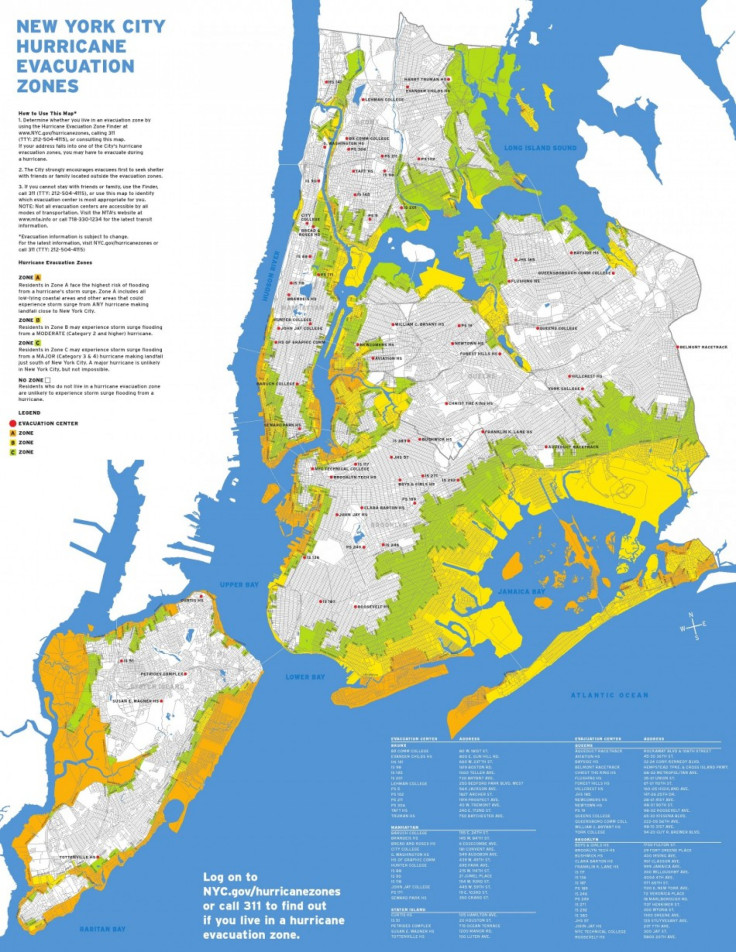Hurricane Irene to Land in New York: What's the Worst That Could Happen?

Although Hurricane Irene's path is still somewhat uncertain, there is increasing likelihood that Irene will make landfall in New York City as a Category 1 storm this weekend, bringing heavy winds and rain.
New York City has not had a direct hit from a hurricane since 1821, when a 13-foot storm surge flooded all of Lower Manhattan, including modern-day Tribeca. Coney Island also suffered severe storm damage, and the storm completely destroyed one of the islands in Hog Island, a set of two islands south of Rockaway Beach.
The Great Hurricane of 1938 (also known as the Long Island Express) also caused significant damage, although it did not make immediate landfall in Manhattan. Corrected for inflation, the storm caused damage to the tune of nearly five billion dollars.
Because hurricanes do not often hit areas of urban congestion, most hurricane preparedness guidelines are biased towards those living in single-family homes in residental waterfront communities. In New York City, many apartment renters -- and even some apartment owners -- may not know how structurally sound their buildings actually are.
All renters should contact their landlords or building superintendents prior to the expected Aug. 28 arrival of Hurricane Irene to determine whether their units have storm or impact-resistant windows. If not, there may still be time to install impact-resistant window laminate that will minimize damage from shattered glass. Diywindowsecurity.com provides purchasing and Do-It-Yourself installation options.
NYC residents can look up any address on the Building Department's Web site (via NYC.gov) to learn when it was built, when it was last modified, and any outstanding violations that might be of concern in the face of catastrophic weather.
It is essential to remove any items on terraces, fire escapes and patios -- like grills and outdoor furniture -- that could potentially get caught up in a gust of wind and crash through a window or a skylight. Window air conditiong units should also be taken inside. Thursday evening would be a good time to make sure all building residents have removed these hazards, as some people may flee the city for the weekend. Residents should also be mindful of dead or dying tree branches close to windows, and make arrangements for those to be removed.
Widespread flooding is expected throughout the city, and the subway systems may be shut down in advance of the heaviest rains, so make sure you are where you need to be well in advance of Hurricane Irene's landfall. As many NYC residents discovered earlier this month, heavy rains can flood basements and snuff out pilot lights in gas boilers. If your building is susceptible, don't wait until it's too late to bathe or wash the dishes.
Depending on where you live in New York City, you may be required to evacuate. As of midday Thursday, officials were still considering whether to force evacuations in low-lying areas like lower Manhattan or South Brooklyn. Areas in four of the five boroughs could be required to evacuate, depending on the severity of the storm.
We don't have enough information yet to make that call, Mayor Michael Bloomberg said in a Queens news conference Thursday morning. The timing is a bit up in the air, as it is with all these things. Sometime on Friday, late in the day. How many depends on how severe we think the storm is going to be.
The city will offer an enormous shelter system for those who face evacuation, according to a report in Bloomberg News.
The mayor is advising NYC residents who might need to flee their homes to prepare go-bags containing nonperishable food, bottled water, medications, and spare sets of keys.
NYC.gov has provided a coded city map* (pictured at left) for residents to determine the likelihood they will be forced to evacuate in anticipation of severe flood damage. (*The Web site is experiencing difficulty as of midday Thursday, likely due to high traffic volume.) At this time, Hurricane Irene is expected to be Category 1 storm when it hits landfall in New York City, meaning that only those in A, or extremely coastal areas, should expect to evacuate.
But as Mayor Bloomberg pointed out, Hurricane Irene's projected strength and path can change regularly. All residents are encouraged to be on the lookout for storm updates by following The National Hurricane Center, The National Oceanic and Atmospheric Administration, and Stormpulse.com.
© Copyright IBTimes 2024. All rights reserved.






















